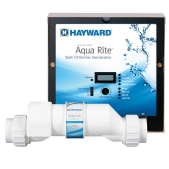 The first thing I want you to understand about Salt Generators is that the salt is not what is sanitizing the pool water. The salt is being converted from sodium chloride (salt) to sodium hypochlorite (chlorine). If you don’t take anything else away from this lecture remember that. One reason I want you to remember that is that this is the basis of the design of all salt generators, most go about it a little differently, but the end result is chlorine is being created from salt in the pool water.
The first thing I want you to understand about Salt Generators is that the salt is not what is sanitizing the pool water. The salt is being converted from sodium chloride (salt) to sodium hypochlorite (chlorine). If you don’t take anything else away from this lecture remember that. One reason I want you to remember that is that this is the basis of the design of all salt generators, most go about it a little differently, but the end result is chlorine is being created from salt in the pool water.
Now that we have the foundation, let’s talk about how the systems work. As I stated before, each system is a little different, but they all operate on the same principal. First, you have a control device that allows you to change the output and gives you feedback on how the system is operating. The control device sends power to a cell. Inside the cell is titanium plates, these plates are coated with a special mineral call ruthenium. The ruthenium is what causes the salt to be converted to chlorine when a small electrical charge is applied to the plates. As this process occurs a small amount of ruthenium is released from the plates and the cell’s efficiency in producing chlorine is reduced. Over a period of time, several years, the cell will be worn out and have to be replaced. How many years it will take the cell to wear out will depend on how many plates are in the cell, how much ruthenium is coated on the plates, and how much time you send power to the cell.
Your goal is to find the lowest possible output that will give you the proper amount of chlorine in the pool (assuming the output level is based on the amount of time the control box sends power to the cell.). In order to know if you have the salt generator set at the proper level you will have to test the water once a week to insure that you have a sufficient amount of chlorine in the pool. If you do not test the water once a week, you run the risk of either over chlorinating the pool and wasting you salt cell, or not producing enough chlorine and developing algae in your pool.
Now that we have covered the salt conversion process, let’s talk about what happens next. You have this chlorine floating around your pool. It is either going to meet up with something it is going to oxidize (kill), or it is going to evaporate. In either case you don’t lose because when the chlorine is done, it goes back into the form of salt and stars all over again. Win, win! They only time you lose salt from the pool is when you add fresh water to the pool. If you have an indoor pool you will rarely add salt. If you have an outdoor pool and it never stops raining you will be adding salt all the time. However, on average you don’t lose much in the way of salt over the course of a year.
Salt generation has many advantages over other types of sanitizers; the biggest advantage is you have an endless supply of chlorine in your pool. If you are gone for ten days and you have a chlorine tablet feeder chances are you will run out of chlorine before you get home. With a salt generator the pool will still have chlorine in the water and it will be clear and blue.
When it comes to troubleshooting a salt generator problem each manufacture’s design is different, so it would be impossible to go over troubleshooting in general. But if you are having a problem with your salt generator get the brand and model of your salt generator then give us a call at Aegean Pools and tell us what your unit is doing and we will help you resolve your problem.
No homework today so go out and enjoy your pool!
© Aegean Pools 2015
